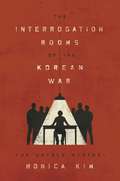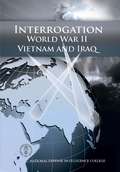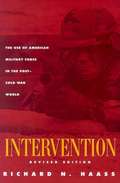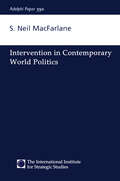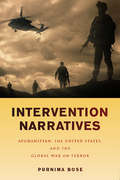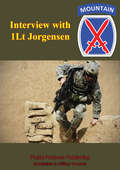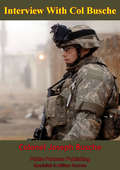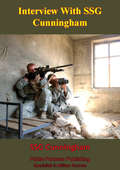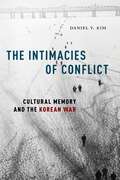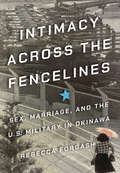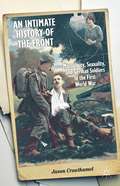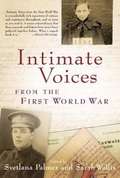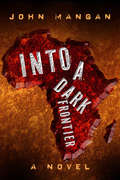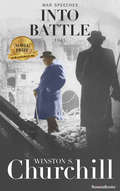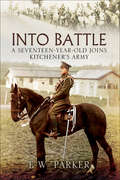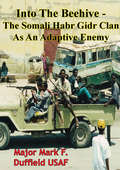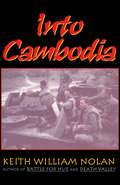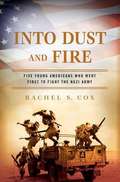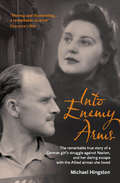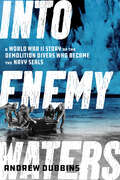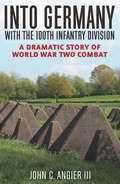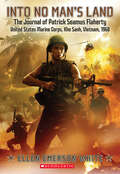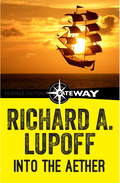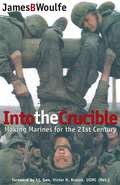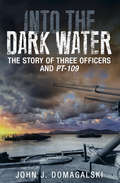- Table View
- List View
The Interrogation Rooms of the Korean War: The Untold History
by Monica KimA groundbreaking look at how the interrogation rooms of the Korean War set the stage for a new kind of battle—not over land but over human subjectsTraditional histories of the Korean War have long focused on violations of the thirty-eighth parallel, the line drawn by American and Soviet officials in 1945 dividing the Korean peninsula. But The Interrogation Rooms of the Korean War presents an entirely new narrative, shifting the perspective from the boundaries of the battlefield to inside the interrogation room. Upending conventional notions of what we think of as geographies of military conflict, Monica Kim demonstrates how the Korean War evolved from a fight over territory to one over human interiority and the individual human subject, forging the template for the US wars of intervention that would predominate during the latter half of the twentieth century and beyond.Kim looks at how, during the armistice negotiations, the United States and their allies proposed a new kind of interrogation room: one in which POWs could exercise their “free will” and choose which country they would go to after the ceasefire. The global controversy that erupted exposed how interrogation rooms had become a flashpoint for the struggles between the ambitions of empire and the demands for decolonization, as the aim of interrogation was to produce subjects who attested to a nation’s right to govern. The complex web of interrogators and prisoners—Japanese-American interrogators, Indian military personnel, Korean POWs and interrogators, and American POWs—that Kim uncovers contradicts the simple story in US popular memory of “brainwashing” during the Korean War.Bringing together a vast range of sources that track two generations of people moving between three continents, The Interrogation Rooms of the Korean War delves into an essential yet overlooked aspect of modern warfare in the twentieth century.
Interrogation World War II, Vietnam, And Iraq: World War Ii, Vietnam, And Iraq
by James A. Stone David P. Shoemaker Major Nicholas R. DottiIn September 2004, the Intelligence Science Board, an advisory board appointed by the Director of National Intelligence, initiated the Study on Educing Information (EI). This study is an ongoing effort to review what is known scientifically about interrogation and other forms of human intelligence collection and to chart a path to the future.As part of our efforts, we have worked closely with faculty and students of the National Defense Intelligence College. The NDIC Press published Educing Information: Interrogation: Science and Art, Foundations for the Future, a book based on Phase I of the Study on EI. Three students, Special Agent James Stone, U.S. Air Force; Special Agent David Shoemaker, U.S. Air Force; and Major Nicholas Dotti, U.S. Army, completed master's thesis studies during Academic Year 2006-07 on topics related to interrogation. Each thesis is a remarkable and useful document.Special Agent Stone researched U.S. efforts during World War II to develop language and interrogation capacities to deal with our Japanese enemy. He found that military leaders, often working with civilian counterparts, created and implemented successful strategies, building on cultural and linguistic skills that substantially aided the war effort for the U.S. and its Allies.Special Agent Shoemaker studied the experiences of three successful interrogators during the Vietnam War. Like S/A Stone, S/A Shoemaker suggests that policymakers and practitioners have much to learn from professionals who served effectively for years in the field educing information. And like Stone, Shoemaker highlights the importance of a deep understanding of the language, psychology, and culture of adversaries and potential allies in other countries.
Intervention: The Use of American Military Force in the Post-Cold War World
by Richard N. HaassFirst published in 1994, this volume addresses the debate over US intervention around the world, including recent cases, the politics of force, learning from history, the future of intervention. An afterword addresses the use of force by the US since 1994. Appendices present relevant documents and remarks by such figures as Caspar Weinberger, Colin Powell, and Bill Clinton.
Intervention in Contemporary World Politics: Intervention In Contemporary World Politics (Adelphi series)
by Neil MacfarlaneExamines multilateral interventions in civil conflicts and the evolution of the role of such interventions in world politics. It focuses primarily on the Cold War and post-Cold War eras and the differences between them. It contests the notion that there is an emerging norm of humanitarian intervention in international politics, arguing that political interests remain essential to the practice of intervention.
Intervention Narratives: Afghanistan, the United States, and the Global War on Terror (War Culture)
by Purnima BoseIntervention Narratives examines the contradictory cultural representations of the US intervention in Afghanistan that help to justify an imperial foreign policy. These narratives involve projecting Afghans as brave anti-communist warriors who suffered the consequences of American disengagement with the region following the end of the Cold War, as victimized women who can be empowered through enterprise, as innocent dogs who need to be saved by US soldiers, and as terrorists who deserve punishment for 9/11. Given that much of public political life now involves affect rather than knowledge, feelings rather than facts, familiar recurring tropes of heroism, terrorism, entrepreneurship, and canine love make the war easier to comprehend and elicit sympathy for US military forces. An indictment of US policy, Bose demonstrates that contemporary imperialism operates on an ideologically diverse cultural terrain to enlist support for the war across the political spectrum.
Interview With 1LT Jorgensen (Eyewitness To Modern War #10)
by Douglas CubbisonDouglas Cubbison, the Command Historian for the 10th Mountain Division, conducted a series of interviews with the soldiers of the 10th Mountain Division in Afghanistan during January 2007, along with several additional interviews conducted in February 2007 at Fort Drum, New York. The interviews are fairly wide ranging in the topics covered but all center around one particularly memorable event for the soldier being interviewed, such as an ambush, a patrol, a firefight, a helicopter crash, or a hero ceremony. This transcript is from the interview with First Lieutenant Jorgensen, Bravo Troop, 3rd Squadron, 71st Cavalry, conducted on 22 January 2007 at Forward Operating Base Naray, Afghanistan.
Interview with Col. Joseph Buche - 101st Airborne Division (Eyewitness To Modern War #8)
by Dr Tom BruscinoHaving assumed command of 3rd Battalion, 187th Infantry Regiment, 101st Airborne Division on D-Day, 6 June 2003, Colonel Joseph Buche initially deployed around the Tall Afar border region before his unit redeployed on short notice to the Al Qaim area where it played a central role in the success of Operation Rifles Blitz...Alerted that 3-187 should be prepared for operations in Najaf or Karbala then Fallujah, the operation in and around the Iraqi-Syrian border town of Al Qaim came as a surprise. "It came out of the blue" said Buche. "I'd never heard of Husaybah or Al Qaim, Iraq." Iron Hammer - 3-187's piece of Rifles Blitz - proved challenging, including the move into a new area of operations and the inherent tensions between the missions assigned...He emphasized several factors which contributed to the success of Rifles Blitz, including the reliability of their interpreters, the integration of psychological operations and information operations into the unit's scheme of maneuver, the ability to mass a lot of soldiers on the ground, the capability of trusted staff officers, and the matching of unit missions with the personalities of unit commanders. The need to establish a position of strength visible to the Iraqi people, he insists, is an imperative for successfully dealing with the populace..."Part of what I wanted to do" Buche added, "was to let any bad guys know that hell was coming to breakfast." Looking back, he proudly boasts that the operation was so successful that the enemy simply failed to fight. "I didn't have a hard time with not having any firefights in that operation at all. I took pride in it because, to me, that was evidence that those company commanders and troopers out there had maneuvered so well that the enemy never found themselves in a position of advantage where they wanted to engage us."
Interview with SSG Cunningham - 10th Mountain Division (Eyewitness To Modern War #7)
by Douglas CubbisonA US Army master sniper in charge of a team of marksmen and forward observers of the 10th Mountain Division recounts his experiences of Afghanistan during Operation Enduring Freedom.
The Intimacies of Conflict: Cultural Memory and the Korean War
by Daniel Y. KimEnables a reckoning with the legacy of the Forgotten War through literary and cinematic works of cultural memoryThough often considered “the forgotten war,” lost between the end of World War II and the start of the Cold War, the Korean War was, as Daniel Y. Kim argues, a watershed event that fundamentally reshaped both domestic conceptions of race and the interracial dimensions of the global empire that the United States would go on to establish. He uncovers a trail of cultural artefacts that speaks to the trauma experienced by civilians during the conflict but also evokes an expansive web of complicity in the suffering that they endured.Taking up a range of American popular media from the 1950s, Kim offers a portrait of the Korean War as it looked to Americans while they were experiencing it in real time. Kim expands this archive to read a robust host of fiction from US writers like Susan Choi, Rolando Hinojosa, Toni Morrison, and Chang-rae Lee, and the Korean author Hwang Sok-yong. The multiple and ongoing historical trajectories presented in these works testify to the resurgent afterlife of this event in US cultural memory, and of its lasting impact on multiple racialized populations, both within the US and in Korea. The Intimacies of Conflict offers a robust, multifaceted, and multidisciplinary analysis of the pivotal—but often unacknowledged—consequences of the Korean War in both domestic and transnational histories of race.
Intimacy across the Fencelines: Sex, Marriage, and the U.S. Military in Okinawa
by Rebecca ForgashIntimacy Across the Fencelines examines intimacy in the form of sexual encounters, dating, marriage, and family that involve US service members and local residents. Rebecca Forgash analyzes the stories of individual US service members and their Okinawan spouses and family members against the backdrop of Okinawan history, political and economic entanglements with Japan and the United States, and a longstanding anti-base movement. The narratives highlight the simultaneously repressive and creative power of military "fencelines," sites of symbolic negotiation and struggle involving gender, race, and class that divide the social landscape in communities that host US bases.Intimacy Across the Fencelines anchors the global US military complex and US-Japan security alliance in intimate everyday experiences and emotions, illuminating important aspects of the lived experiences of war and imperialism.
An Intimate History of the Front: Masculinity, Sexuality, And German Soldiers In The First World War
by Jason CrouthamelThis eye-opening study gives a nuanced, provocative account of how German soldiers in the Great War experienced and enacted masculinity. Drawing on an array of relevant narratives and media, it explores the ways that both heterosexual and homosexual soldiers expressed emotion, understood romantic ideals, and approached intimacy and sexuality.
Intimate Voices from the First World War
by Sarah Wallis Svetlana PalmerIn the tradition of the work of Studs Turkel and Ken Burns' "The Civil War," this book is the companion volume to a major television series--a compelling, personal account of World War I and its devastating aftermath. Photos & maps throughout.
Into a Dark Frontier
by John Mangan"Into a Dark Frontier is cut from the same cloth as the best of Vince Flynn and Brad Thor."—James RollinsIn the near future, Africa collapses into an enormous failed state, leaving the continent lawless and severely depopulated. For most, the breakdown brings horror, but for others—the outcast, the desperate, the criminal, and the insane—it allows unparalleled opportunity: a new frontier of danger and unlimited possibility.In America, ex-Navy SEAL Slade Crawford, emotionally crippled after twenty years of front line combat, the dissolution of his marriage, and the accidental death of his son, is falsely accused of terrorism. Slade flees to Africa to build a new life and escape his past, but he is captured by an enigmatic American colonel, Gary Kraven, and blackmailed into tracking down a blood cult that is rampaging across the sub-Sahara. Struggling to stay alive and to free himself from Kraven’s grasp, Slade pursues the cult across the lawless African frontier. He soon learns that nothing is as it seems and that he is standing at the epicenter of a global struggle that will determine the course of history. Slade must decide whether to fight for his life or his honor—he can't have both.
Into Battle (Winston S. Churchill War Speeches #1)
by Winston S. ChurchillThis first volume of collected essays and journalism from the Nobel Prize–winning prime minister includes some of his most important WWII speeches. Legendary politician and military strategist Winston S. Churchill was a master not only of the battlefield, but of the page and the podium. Over the course of forty books and countless speeches, broadcasts, news items and more, he addressed a country at war and at peace, thrilling with victory but uneasy with its shifting role in global politics. In 1953, he was awarded the Nobel Prize for Literature for &“his mastery of historical and biographical description as well as for brilliant oratory in defending exalted human values.&” During his lifetime, he enthralled readers and brought crowds roaring to their feet; in the years since his death, his skilled writing has inspired generations of eager history buffs. Churchill was at his best when rallying Britons to the twin causes of war and justice, delivering inspiration and hope during the hard years of bombings, violence, sacrifice, and terror. This compilation, composed of speeches made in the early years of the war, contains some of his best. Profound words from famous speeches in this collection include: &“This was their finest hour;&” &“Never in the field of human conflict was so much owed, by so many, to so few;&” and &“I have nothing to offer but blood, toil, tears and sweat.&” Many decades after the end of the war, Churchill&’s words still have the power to stir the blood—and inspire the heart. A must-read for all WWII history fans.
Into Battle: A Seventeen-Year-Old Joins Kitchener's Army
by E.W. ParkerWritten well over ninety years ago while the experiences of youth were still fresh in the authors mind, this is the story of a seventeen-year-old boy from the time he joined Kitcheners Army, as one of the first hundred thousand in 1914, until he found himself in hospital—an officer with the Military Cross—recovering from his last wound, on the day of the Armistice, 11 November, 1918.In no way a formal record of the great and terrible events it describes, this is a purely personal, almost private, account. It is a plain, unvarnished tale—and even more effective for that—of heroism, and the horror peculiar to trench warfare of the First World War.Interspersed with moments of pity, humor and a deep response to natural beauty and peace out of the firing line, it is a record, which in its details, direct simplicity and manner of telling, comes nearer to the truth than many more ambitious accounts.
Into The Beehive - The Somali Habr Gidr Clan As An Adaptive Enemy
by Major Mark F. Duffield USAFOn October 3rd 1993, US efforts in Somalia culminated as the result of an overnight battle that cost eighteen American lives and effectively silenced all optimism that Somalia could be externally resurrected as a functioning state. What began as a humanitarian mission to abate starvation had evolved into the absurdity of outright combat against the very people meant to be saved. Beyond the issues of political policy, lurks a disturbing fact that remains unaddressed by the US military. Out of the anarchy that was Somalia in 1993--and is like many other places where US forces may be, committed--an untrained, ill-equipped, and undisciplined enemy quickly adapted their tactics, invalidated key US planning assumptions, and evolved into a lethal force. The Habr Gidr's tactical adaptation outpaced the planning efforts of elite US units and achieved their tactical, operational and strategic goals at US expense.This monograph explores how this adaptation occurred. It goes beyond the common theories concerning equipment, tactics, and the inherent difficulties of combined operations to look at the very nature of adaptation itself. It provides a different view of events in Somalia in hopes of better informing military planners facing a similar opponent. At its heart, this monograph explores the possibility that what appeared to be little more than an anarchic mob may have been a functioning complex adaptive system.
Into Cambodia: Spring Campaign, Summer Offensive, 1970
by Keith William Nolan"Most of us remember (the 1970 Cambodian campaign) best for the killings of four young people at Kent State. Nolan wants us to remember that it killed a lot of young Americans in Cambodia as well. " -- The Capital Tittles (Madison, WI)"This is combat narrative at its best. Nolan has mastered the soldier's slang and weaves it expertly into the account . . . . full of combat anecdotes detailing battlefield leadership successes and failures. " -- Military Review
Into Dust and Fire
by Rachel S. CoxThe untold story of five young American friends who left the ivory towers at Harvard and Dartmouth to take on Rommel's Panzers under the blazing sun of North Africa... In the spring of 1941, with Europe consumed by war and occupation, Britain stood alone against the Nazi menace. The United States remained wary of joining the costly and destructive conflict. But for five extraordinary young Americans, the global threat of fascism was too great to ignore. Six months before Pearl Harbor, these courageous idealists left their promising futures behind to join the beleaguered British Army. Fighting as foreigners, they were shipped off to join the Desert Rats, the 7th Armoured Division of the British Eighth Army, who were battling Field Marshal Rommel's panzer division. The Yanks would lead antitank and machine-gun platoons into combat at the Second Battle of El Alamein, the twelve-day epic of tank warfare that would ultimately turn the tide for the Allies. A fitting tribute to five men whose commitment to freedom transcended national boundaries, Into Dust and Fire is a gripping true tale of idealism, courage, camaraderie, sacrifice, and heroism. INCLUDES PHOTOS
Into Enemy Arms: The Remarkable True Story of a German Girl’s Struggle against Nazism, and Her Daring Escape with the Allied Airman She Loved
by Michael HingstonThe suspenseful true story of a love that defied Nazi oppression, and a harrowing journey to freedom. In 1945, Ditha Bruncel was living with her parents in the small town of Lossen, in Upper Silesia. Close Jewish friends had vanished, swastikas hung from every building, and neighbors were disappearing in the middle of the night. At the same time more than fifteen hundred British and Commonwealth airmen were being marched out of Stalag Luft VII, a POW camp in the same region. Twenty-three of these prisoners managed to escape from the marching column—and by chance hobbled into Lossen. One among them, Warrant Officer Gordon Slowey, was the man Ditha was destined to meet and fall in love with. Into Enemy Arms tells the extraordinary story of Ditha and the escaped POWs she helped save. Together, they embarked on a dangerous and daring flight out of Germany. As they faced exhaustion, hunger, extreme cold, and the constant risk of discovery, Ditha and Gordon’s love for one another intensified, and so did their determination to survive and escape.
Into Enemy Waters: A World War II Story of the Demolition Divers Who Became the Navy SEALS
by Andrew DubbinsA veteran US frogman recounts his experiences in World War II and the risky pre-invasion missions of the Underwater Demolition Teams.?Into Enemy Waters is the story of World War II’s most elite and daring unit of warriors, the direct precursors to the Navy SEALs, told through the eyes of its last living member, ninety-five-year-old George Morgan.Morgan was just a wiry, seventeen-year-old lifeguard from New Jersey when he joined the Navy’s new combat demolition unit, tasked to blow up enemy?coastal defenses ahead of landings by Allied forces. His first assignment: Omaha Beach on D-Day.When he returned stateside, Morgan learned that his service was only beginning. Outfitted with swim trunks, a dive mask, and fins, he was sent to Hawaii and then on to deployments in the Pacific as a member of the elite and pioneering Underwater Demolition Teams. GIs called them “half fish, half nuts.” Today, we call them frogmen—and Navy SEALS.Led by maverick Naval Reserve Officer Draper Kauffman, Morgan would spend the fierce final year of the war swimming up to enemy controlled beaches to gather intel and detonate underwater barriers. He’d have to master the sea, muster superhuman grit, and overcome the demons of Omaha Beach.Moving closer to Japan, the enemy’s island defenses were growing more elaborate and its soldiers more fanatical. From the black sand beaches of Iwo Jima to the shark infested reefs of Okinawa, to the cold seas of Tokyo Bay, teenaged George Morgan was there before most, fighting for his life. And for all of us.Perfect for fans of?Unbroken,?The Right Stuff, and?Band of Brothers.Praise for Into Enemy Waters“A compelling narrative full of World War II fireworks.” —Kirkus Reviews“A rousing history. . . . Drawing on extensive interviews with Morgan, Dubbins creates a vivid and fast-moving narrative of courage and sacrifice under the most extreme conditions. WWII buffs will be thrilled.” —Publishers Weekly“This well-researched book is both visceral and uplifting, telling of a time of great courage, integrity and camaraderie.” —Jill?Heinerth,?author of Into The Planet: My Life as a Cave Diver
Into Germany with the 100th Infantry Division
by John C. AngierInto Germany with the 100th Infantry Division, first published in 1959 as MOS 1542: A Dramatic True Story of Combat in World War Two, is the fast-paced account of Sergeant (later Lieutenant) John Angier’s experiences as an infantryman in France and Germany. Included are vivid descriptions of the platoon’s battles and life at the front, as Angier’s platoon was at the frontline “for 175 consecutive days of hell,” losing 3 lieutenants and 38 men; only 5 of the original platoon remained at war’s end. For his service Angier received 13 decorations including the Combat Infantry Badge, Bronze Star with Cluster, Good Conduct Medal, Victory Medal, Occupation Germany Medal, Expert Infantryman Badge, American Defense Medal and National Security Medal. Angier passed away on March 29, 2005.
Into No Man’s Land, the Journal of Patrick Seamus Flaherty, United States Marine Corps, Khe Sanh, Vietnam: The Journal Of Patrick Seamus Flaherty, United States Marine Corps, Khe Sanh, Vietnam 1968
by Ellen Emerson WhiteThe Vietnam War journal of Patrick Seamus Flaherty is now available in paperback, with an exciting repackaging! Determined to do his duty for his country, Patrick Seamus Flaherty joins the Marines right after graduation to fight in the Vietnam War. But Southeast Asia is a far cry from Patrick's hometown of Boston, and as soon as he arrives, he realizes that he's made a terrible mistake.Confronted with oppressive heat, dense jungles, and an enemy that is everywhere, Patrick is overwhelmed by life on the battlefield. With the help of his comrades, Patrick slowly starts to find a way to deal with the harsh realities he faces. But under constant assault by the North Vietnamese, Patrick isn't sure he'll ever make it home again, and as the months drag on, he and his unit question whether they're actually making a difference. Writing in the journal his father gave him before shipping out, Patrick brings Khe Sanh to vivid life through the smells, tastes, sounds, horrors, loneliness, and the friendships that are so much of the chaos called war.
Into the Aether
by Richard A. LupoffWhen the Chester A. Arthur, the world's first and only coal/steam/paddlewheel-propelled spaceship rose into the skies over Buffalo Falls, Pa., who would have expected what followed?Will Professor Thintwhistle and his crew be able to return to earth? Will Miss Taphammer ever find them? Will Jefferson Jackson Clay's foul plot succeed? And what of the King of the Cats?
Into the Crucible: Making Marines for the 21st Century
by James WoulfeThis book describes the 54 hour exercise in which recruits are put through a series of taxing challenges whilst being denied sufficient food or sleep. Woulfe compares this training exercise with other schemes in other branches of service.
Into the Dark Water: The Story of Three Officers and PT-109
by John J. DomagalskiThe complete World War II record of one of the most celebrated warships in American history—made famous by her final commanding officer, John F. Kennedy.Fleshing out the little-known chronicle of this patrol torpedo boat under two officers during the swirling battles around Guadalcanal, “John Domagalski brings PT-109 and her crew back to life once again and, in doing so, honors all who served in the patrol torpedo service” (Military Review).In these mainly nocturnal fights, when the Japanese navy was at its apex, America’s small, fast-boat flotillas darted in among the enemy fleet, like a “barroom brawl with the lights turned out.” Bryant Larson and Rollin Westholm preceded Kennedy as commanders of PT-109, and their fights leading the ship and its brave crew hold second to none in the chronicles of US Navy daring. As the battles moved on across the Pacific, the PT-boat flotillas gained confidence, even as the Japanese, too, learned lessons on how to destroy them.Under its third and final commander, Kennedy, PT-109 met its fate as a Japanese destroyer suddenly emerged from a dark mist and rammed it in half. Two crewmen were killed immediately, but Kennedy, formerly on the swim team at Harvard, was able to shepherd his wounded and others to refuge. His unsurpassed gallantry cannot resist retelling, yet the courage of the book’s previous commanders have not until now seen the light of day.This book provides the complete record of PT-109 in the Pacific, as well as a valuable glimpse of how the American Navy’s daring and initiative found its full playing field in World War II.
